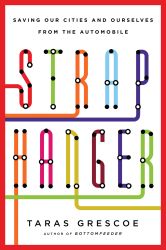336 pages
© 2012 Taras Grescoe
The cheap energy era is over, unless someone invents a Star Trek replicator that can magick barrels of oil into existence. Cities across the world are working to meet the challenge of keeping millions of people moving and their local economies growing by investing in mass transit. In Straphanger, Taras Grescoe visits thirteen cities in the Americas, Europe, and Asia to experience their transportation systems, finding what what works and what doesn't. These cities include not only those with long-successful and fully integrated systems, like Paris and Tokoyo, but cities like Phoenix which were built for the automobile and which are now trying to transform themselves. Watching these cities strive for the future has for Grescoe all the thrill of attending a rocket launch: when they're successful, it's glorious, but when they fail...the results aren't pretty. Happily for Grescoe and readers, most of his accounts are of successful takeoffs -- and even the failures have something to teach.
Prior to the automobile, the great urban centers of the industrial age depended on transit systems to keep their expanding population mobile: even small cities could boast a trolley system. But as the automobile zoomed into the historical spotlight, these systems were abandoned and destroyed -- until now. The transit renaissance is not only bringing old systems back to life, but bettering them: only only are trains cleaner and faster these days, but the systems themselves are better thought-out. Take buses, for instance, which are increasingly being taken out of congested traffic and deployed in Bus Rapid Transit systems, in which they're given a full lane of the road, dedicated to them. Those who board these have pre-purchased tickets, much like train lines -- allowing BRT drivers to more than double the average speed of their buses outside the system. BRT systems are ideal for poorer cities in desperate need of transit, but which lack the means to create more involved systems. like subways.
Straphanger combines history and public policy, covering traditional transit (trolleys, trains, and subways), transitional transit with a twist (BRT), and bicycles as well. Although bicyles are individual vehicles, Grescoe demonstrates how they can be connected to cities' mass transit systems. For instance, in Paris, a Metro ticket that allows subway access can also be used to rent a bicycle to take to the train station -- and bus stops there nearby, as well. Copenhagan's history of recent expansion has been done while simutaneously promoting bicycle use, making it in Grescoe's view an excellent choice for American cities to study. The great lesson of Straphanger is that for mass transit to succeed, it must consist of a network that people can actually use to get places. Busses that run erratically are of no use to people who need to get to work on time, and bike lanes that go nowhere do more harm to the cause of bike commuting than good. Integration is a key element of that, both in working in transit options where people live, work, and shop, and in connecting those options to expand people's opportunities. Paris' achievements in this field make it Grescoe's favorite, but Straphanger's writing doesn't focus just on functionality: he points out how transit can be a place for civic art, as exemplified by Moscow's subway, and expand people's quality of life: cycling is fun, far more than sitting in gridlock.
Straphanger is a winsome, thoughtful, and entertaining book which should be of interest to citizens who want to make their communities better and more sustainable places to live.
Related:
Walkable City, Jeff Speck
Pedaling Revolution, Jeff Mapes
Waiting on a Train, Jeff McCommons
The Green Metropolis,

No comments:
Post a Comment
Thank you for visiting! Because of some very clever spambots, I've had to start moderating comments more strictly, but they're approved throughout the day.